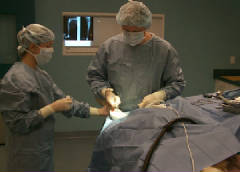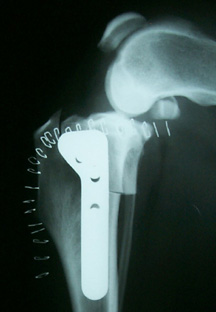Cruciate Repair Methods
What procedure should be performed to repair a ruptured cranial cruciate ligament?
This question has continued to be the hot topic of the last several ACVS Symposium meetings. The commonly performed cranial cruciate ligament repairs today are the TPLO (Tibial Plateau Leveling Osteotomy), TTA (Tibial Tuberosity Advancement), and lateral fabellar suture imbrications. The fibular head transposition has fallen out of favor, as well as the intra-articular repairs that are commonly performed in humans. A "new" technique is the TightRope repair. The problem with comparing the different procedures is a lack of controlled clinical trials and the fact that there isn't a good objective measure to compare the procedures. Typical measures comparing procedures have included pet owner or surgeon evaluation/happieness with the outcome, goniometery (measuring the joint angles), force plate evaluation, and kinesiology. Subjectively, we feel these measures to not demonstrate the full potential of a patient at full performance, like field trial or agility. SUBJECTIVELY, TPLOs and TTAs will consistently get dogs back to an athletic performance level; lateral sutures will not consistently do this

TPLO repair at ProFormance Canine.
TPLO
There are still no large scale clinical studies on the Tibial Plateau Leveling Osteotomy (TPLO) procedure. The following recommendations are based upon years of experience with the procedure by Dr. Huss. Dr. Huss started performing the TPLO procedure in 1997, and currently has performed over 14,000 TPLO surgeries. The TPLO instrumentation and implants are now manufactured by many companies and have expanded to at least 4 different size bi-radial saw blades (14, 18, 24 & 30 mm radius) and 6 different size plates (2.0, 2.7, 3.5 mm mini, 3.5 mm, 3.5 mm broad & Jumbo). This range of sizes permits a surgeon the ability to perform the TPLO procedure on animals ranging in size from approximately 10 pounds to over 250 pounds. The smallest size TPLO plate (2.0 mm) is equivalent in size to human finger plates. The tiny plates are even more technically demanding to implant than the already demanding standard (3.5 mm) TPLO. Each year more and more basic science research has validated Dr. Slocum's recommendations and research on the TPLO. There is no longer a question as to whether the procedure works. The big questions now are 1.) Is the the TPLO better than other techniques and 2.) Which patients benefit from the TPLO procedure. Having performed some of the largest numbers of TPLO procedures, we feel qualified to make the following recommendations based upon our experience:
- It takes 50-75 TPLO procedures to become proficient with this complex surgery.
- We do not recommend bilateral TPLO repairs at the same surgery.
- TPLO repairs can be performed on any age animal, however, care must be taken in imature animals with open tibial physis.
- The TPLO can be used succesfully as a revision surgery in patients that have done poorly with other cruciate repair techniques.
- The TPLO can consistently get athletic dogs back to performance level.
- The TPLO can be performed on cats and dogs from ~10-15 pounds to over 250 pounds. The size of the bone related to implant size is the determining factor. TPLOs on small animals should only be performed by surgeons very experienced with the procedure.

Postop radiograph of a TPLO using a 3.5 mm broad NGD plate.
TTA
There are even fewer clinical studies on the Tibial Tuberosity Advancement (TTA) procedure. The procedue was developed in Switzerland after the political fall-out of the TPLO. The procedure results in changes in force in the stifle that eliminates the need for the cranial cruciate ligament in a similar manor as the TPLO. The most recent studies are showing similar benefits to the TPLO. The complications are different than the TPLO, but there are new complications related to this specific procedure. The early reports were that the procedure was easier to perform that the TPLO, but that doesn't appear to be the case. The TTA instrumentation and implants are now manufactured by many companies and have multiple sizes and metallic make-up. There MAY be problems using this technique on giant breed dogs due to implant size constraints. All-in-all, the TPLO and TTA are comperable procedures. We have elected to continue performing just the TPLO procedure since we are intimately familiar with all of the subtle issues involved with this technique
Lateral Fabellar Suture
For many years, the lateral fabellar suture had been the gold standard for cranial cruciate ligament repair in small animals. Originally described by Dr. DeAngelis, and then modified by Dr. Flow, the technique has recently had many different options made available for the type of suture that can be used. The lateral fabellar suture is a stabilizing technique that is outside the joint, but under the muscles of the knee. The suture material is supposed to approximate the pull of the cranial cruciate ligament going from the tibial crest to behind the lateral fabella of the distal femur(Dr. Flow also put a suture medially). The technique will stabilize the joint, but it can be very binding. Nearly every technique will losen fairly quickly after surgery. So the patient needs to put scar tissue down around the joint before the suture losens. Large diameter braided suture material was originally used as the suture of choice. There were many complications with infection, bacteria lodging in the braids of the suture. Large diameter monofilament nylon is now typically used, starting with fishing line; there are now several sources of nylon specifically made for this procedure. Recently, newer kevlar materials have been made available as the suture. Metallic crimps have also been developed in place of tying the suture in a knot. These techniques are relatively easy to perform by family veterinarians and boarded surgeons. We have found, however, that there are many subtle technical issues that have to be addressed or there will be problems.
TightRope
This is a newly developed extra-capsular suture repair technique for cranial cruciate ligament ruptures. There are few published reports in the medical journals on this technique. The technique uses newer materials (kevlar suture) in a novel pre-formed implant. The method can be done through a limited approach to the joint. The end result is very similar to a fibular head transposition with the suture material going between the tibial crest and the lateral aspect of the distal tibia. Since over 50-70% of patients with ruptured cranial cruciate ligaments also have meniscal injuries, the interior of the joint still needs to be visualized. This can be done minimally invasively with arthroscopy. Otherwise, the technique could be performed open. At ProFormance Canine, we are always looking to explore better ways of treating our patients. We will keep you informed on this technique as more information becomes available.
Recommendations Based Upon Patient Size
10-35 pound patients
- Patients < 20 pounds may not need surgery if they show significant signs of improvement within 2 weeks of injury and do not have signs of meniscal injury. Treatment should entail strict cage rest for a month with NSAIDS. If they are not significantly improved within 2-3 weeks, consider surgery.
- Patients in this weight range will likely do well with any surgical procedure. We perform the TPLO procedure or lateral fabellar suture stabilization. The only subset of patients we have noted, are dogs with extremely steep tibial slopes (30+ degree). These dogs have not done well with lateral fabellar sutures. When revised with TPLO surgery, they have done excellent.
35-60 pound patients
- We offer both TPLO and lateral fabellar suture repair for the dogs in this weight group.
- If the dog is a performance/working dog, or the owner wants to maximize the potential for a good functional outcome, we recommend the TPLO.
60-250+ pound patients
- We strongly recommend TPLO repair for the dogs in this weight group. If for no other reason, studies have demonstrated that dogs with TPLO surgery will start weight bearing on the surgery leg sooner than with any other repair technique.
- We recommend the TPLO repair exclusively for Rottweilers. The curvature in this breed's hindlimbs has resulted in an increased incidents of problems with other cruciate repair techniques.
- The giant size dogs have resulted in concern for implant size. Some surgeons are double plating the 200+ lbs. size dogs. We have not, but we are looking forward to a new larger size plate. We have had giant breed dogs bend the plate when they have not been properly confined.
The preceding statements are based upon our years of experience with thousands of TPLO procedures. From our first TPLO (a Bull Mastiff who went on to a CDX obediance title) our goal was to duplicate Dr. Slocum's technique as precisely as possible. Our hope was to achieve the same success he had reported. We have been able to do that. Over the years, we have made very slight modifications to the technique based upon problems or issues we had found with the way our patients had responded.